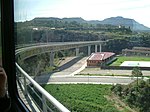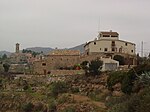Santa Cueva de Montserrat

The Santa Cova de Montserrat (in Catalan; English: Holy Cave of Montserrat) is the hillside cave on Montserrat where the Virgin of Montserrat was traditionally hidden during the Moorish invasions and later discovered by shepherds in 880. Its discovery made Montserrat into a pilgrimage destination, and led to the founding of the Santa Maria de Montserrat Abbey. The sanctuary of the Santa Cova is accessed by a path, called the Camí de la Santa Cova, carved along the ridge of the mountain. It was built between 1691 and 1704, thanks to the patronage of Gertrudis de Camporrell, marquess of Tamarit. Between 1896 and 1916, a series of sculptures were placed along the camí, dedicated to the rosary and the 15 mysteries of the Virgin, including works by Antoni Gaudí, Josep Puig i Cadafalch and other modernista artists.
Excerpt from the Wikipedia article Santa Cueva de Montserrat (License: CC BY-SA 3.0, Authors, Images).Santa Cueva de Montserrat
Camí de la Santa Cova,
Geographical coordinates (GPS) Address Nearby Places Show on map
Geographical coordinates (GPS)
| Latitude | Longitude |
|---|---|
| N 41.5882 ° | E 1.8441 ° |
Address
Camí de la Santa Cova
Camí de la Santa Cova
08293
Catalonia, Spain
Open on Google Maps










